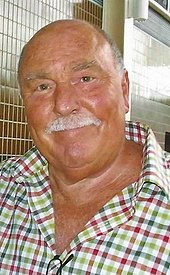1959–60 Burnley F.C. season
The team, and their manager Harry Potts, endured a tense season in which Tottenham Hotspur and Wolverhampton Wanderers were the other contenders for the league title.During the season, 18 players made at least one appearance for the club, with Jimmy Adamson, Brian Miller and Ray Pointer present in all 50 competitive matches.The highest attendance recorded at home ground Turf Moor was 52,850 for the FA Cup fifth-round replay match against Bradford City; the lowest was 17,398 for a league game against Leeds United.[6][9] Burnley were one of the first to set up a purpose-built training ground (at Gawthorpe in 1955),[6][10] which included a medical room, a gymnasium, three full-size pitches and an all-weather surface.[6][13] Billy Wright of Wolverhampton Wanderers described Burnley's playing style as "progressing [from defense to attack] by nicely controlled patterns with every man searching hungrily for space".[20] Burnley's First Division campaign began with a 3–2 win over Leeds United at Elland Road on 22 August, with goals from Brian Pilkington, John Connelly, and Ray Pointer.[21] Burnley's form remained inconsistent: a 4–1 away loss against Chelsea was followed by 2–1 wins against local rival Preston North End and West Bromwich Albion, after coming from behind on both occasions.[25] Before the East Lancashire derby at Blackburn Rovers on 17 October, Potts received criticism from the Burnley supporters who objected to his "confusing playing style", such as the defenders switching positions during matches.[15] Two weeks later, Burnley recorded their largest post-war league win when they beat Nottingham Forest, the previous season's FA Cup winners, 8–0 at home.The team turned the match around: Jimmy Adamson, Burnley's captain, scored a penalty kick halfway through the second half and Connelly completed a hat-trick inside 16 minutes.[29] On Boxing Day, Burnley defeated Manchester United 2–1 at Old Trafford; forward Ian Lawson came back into the team after three years and scored the winner.[33] On 1 March, the team recorded a 2–0 home win over league leaders Tottenham to close the gap to three points, but with two games in hand on Spurs.[21] It was Seith's last match for the club; he read in the Burnley Express that he would not play the next game against Nottingham Forest and was aggrieved at not being told directly by Potts.[35] The team recorded three consecutive wins: Forest and Leicester City were both defeated 1–0, while Burnley beat Luton 3–0 despite only having 10 men for most of the game, after Pointer came off injured.[35][37] On 18 April, Meredith scored his first goal in a 2–1 defeat in the return game at Leicester, with former Burnley player Cheesebrough netting the winner for the home team.[35] On 2 May, in front of almost 66,000 spectators at Maine Road—including Wolves manager Stan Cullis and several of his players—Burnley went ahead after four minutes when Pilkington's shot deflected off City's Bert Trautmann into the net.[39] Burnley's population had reduced by around 20 per cent since the club won the First Division in 1921; with 80,000 inhabitants in 1960, the town became one of the smallest to have hosted an English first-tier champion.Miller, Adamson and Pointer featured in all 50 league and cup games; Blacklaw, John Angus and Pilkington each missed one First Division match and made 49 appearances for the club.[42] GK = Goalkeeper, DF = Defender, MF = Midfielder, FW = Forward Source:[16] Burnley also participated in the local Lancashire Cup, although their starting line-ups consisted primarily of reserve and youth players.The stadium announcer often misinterpreted the referee's decisions, the crowd showed little interest in the games, and according to McIlroy, every match would end with a countdown "worthy of a space-rocket launching".


Burnley1959–60Bob LordHarry PottsTurf MoorFirst DivisionFA CupJohn ConnellyBradford CityLeeds UnitedHome colours1959–60 seasonBurnley Football Club61st seasonFootball Leaguetop tier of English footballTottenham HotspurWolverhampton WanderersFirst Division championship1920–21Manchester CityAlex ElderJimmy McIlroytransfer feeBurnley's youth academyBlackburn RoversreplayLancashire CupManchester Unitedfirst editionInternational Soccer LeagueJimmy AdamsonBrian MillerRay Pointer1959–60 campaignpromotionSecond Division1946–471958–59 seasonsixth round of the FA CupmanagersArthur HopcraftKhrushchevtraining groundGawthorpepitchesscouting systemJack HixonNorth East EnglandJimmy Greaves4–4–2 formationTotal FootballBilly Wrightclub's youth academyGlentoranKen BracewellTranmere RoversAlbert CheesebroughLeicester CityDoug NewlandsStoke CityLes Shannonpre-season friendlyJimmy RobsoncollarElland RoadBrian PilkingtonEvertonmatchday programmeWest Ham UnitedChelseaPreston North EndWest Bromwich Albionstarting line-upBilly WhiteBobby Seithgiant urticariaTommy CummingsEnglandTom FinneyNewcastle UnitedBirmingham CityDave MackayDanny BlanchflowerplaymakerBlackpoolEast Lancashire derbyLuton TownNottingham ForestFA Cup winnersclean sheetFulhamBolton WanderersArsenalHighburyhalf-timecaptainpenalty kickhat-trickstrain injuryBoxing DayOld TraffordIan LawsonSunday PictorialSheffield WednesdayBurnley Expressmidfieldcartilage injuryTrevor MeredithMaine RoadJim FurnellAdam BlacklawMolineux Stadiumgoal averageStan CullisBert TrautmannJoe Hayesvolleytop flight titleDaily Mirrorwon the First Division in 1921Own goalPilkingtonConnellyPointerRobson